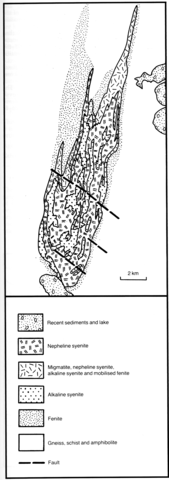stripes
The Ilmenogorskii complex extends for 18 km in a north-northeasterly direction and has a maximum width 4.5 km. It is situated in the domed part of the Urals anticlinorium structure which expands southwards but is greatly compressed to the north. The contacts of the complex are complicated and accompanied by numerous injections of the alkaline rocks into the country rocks, which are fenitized. The massif is heterogeneous with the predominant miaskitic biotite-nepheline syenites occupying 38% of the area, amphibole miaskitic nepheline syenites 18% and biotite syenites 14%. In addition, about 20% of the area is occupied by biotite-nepheline syenites which interdigitate with syenites and biotite plagiosyenites, while 10% is taken up by amphibole-nepheline syenites which interdigitate with syenites and amphibole plagiosyenites. Dykes of miaskitic aplite are also found. Hundreds of pegmatite bodies have been discovered which include granite, miaskitic nepheline syenite and syenite pegmatites. The miaskitic nepheline syenites contain about 30% nepheline, orthoclase, oligoclase, albite and lepidomelane or biotite together with accessory magnetite, zircon, pyrochlore, titanite and ilmenite. The nepheline syenite pegmatites form concordant and, rarely, cross-cutting vein-like bodies up to 2m thick which stretch for tens of metres, as well as small lenses. They occur mainly within the miaskitic nepheline syenites and rarely in the enclosing rocks. They are represented by two varieties: biotite-nepheline-microcline and muscovite-nepheline-microcline. Typically they also include cancrinite, sodalite, ilmenite, zircon, apatite, calcite, pyrochlore and zeolites. Amongst the nepheline syenites restricted zones, up to 0.5 m across, of biotite-calcite rocks with apatite are sometimes found. Narrow calcite veins with apatite, titanite, magnetite ilmenite, pyrochlore, orthite, fluorite and sulphides are more widespread. According to Ronenson (1966) the nepheline syenites are the result of anataxis and the final product of the metasomatic alteration of the enclosing rocks. Isotope studies of Kramm et al. (1983) and Chernyshev et al. (1987) indicated Rb-Sr ratios of 0.703290±0.0023. Calcite from carbonatite gave d18Oo/oo values of +6.6 to +7.0 and silicates from miaskitic nepheline syenite +5.6 (Kononova et al., 1979). Melting experiments using miaskite samples from Ilmenogorskii in the presence of aqueous fluids are reported by Shchekina et al. (1985).
*CHERNYSHEV, I.V., KONONOVA, V.A., KRAMM, U. and GRAUERT B. 1987. Isotope dating of Urals alkaline rocks in the light of U-Pb data for zircons. Geochemistry International, 24 (10): 1-15.
KONONOVA, V.A., DONTSOVA, E.I. and KUZNETSOVA, L.D. 1979. Isotopic composition of oxygen and strontium of the Ilmen-Vishnevy Gory alkaline complex and problems of miaskite genesis. Geokhimiya, 12: 1784-95.
*KRAMM, U., BLAXLAND, A.B., KONONOVA, V.A. and GRAUERT, B. 1983. Origin of the Ilmenogorsk-Vishnevogorsk nepheline syenites, Urals, USSR, and their time of emplacement during the history of the Ural fold belt: a Rb-Sr study. Journal of Geology, 91: 427-35.
LEVIN, V.Y. 1974. The alkaline province of the Ilmenogorsk-Vishnevy Gory (formation of the nepheline syenite of the Urals). Nauka, Moscow. 224 pp.
Ronenson, 1966; Semonov et al., 1974; *Shchekina et al., 1985.


